Sony KD-65XF9005 Review
Sony KD-65XF9005
A stellar start for TVs in 2018
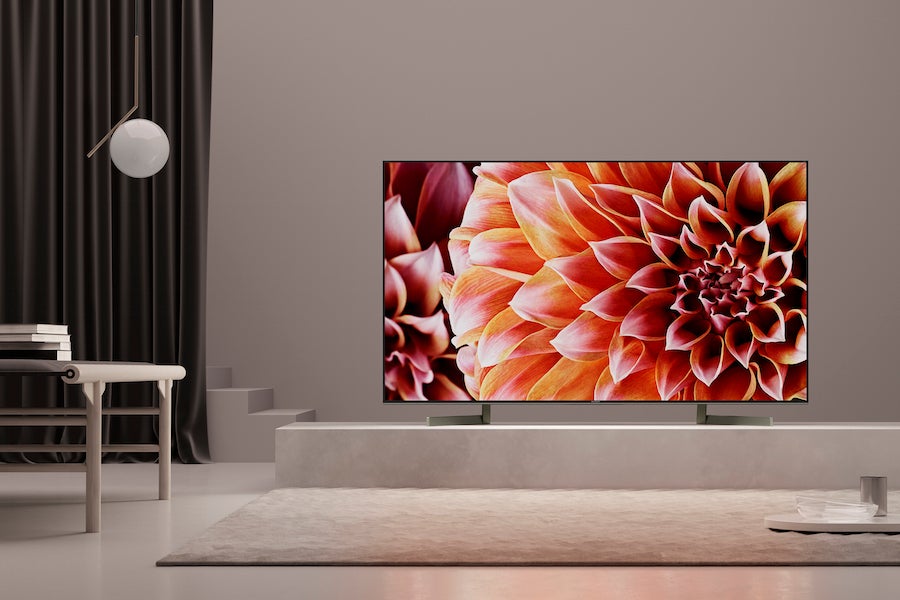
Verdict
Pros
- Excellent contrast for a mid-range TV
- Impressive colours and sharpness
- Class-leading motion processing
Cons
- Android TV is still a clumsy smart TV system
- Occasional backlight blooming around bright objects
- Limited viewing angles
Key Specifications
- Review Price: £2,200
- 65-inch LCD TV with direct LED lighting
- Native 4K UHD resolution
- HDR10 and HLG high dynamic range support, with Dolby Vision to come via an update
- Android TV 7 smart TV system
- Local dimming backlight control
What is the Sony KD-65XF9005?
The 65-inch Sony KD-65XF9005 is essentially a new mid-range 4K HDR TV with high-end aspirations. Crucially it continues the unusual (for a mid-range TV) direct backlighting approach that made last year’s XE9005 range so critically and commercially successful.
It also, though, delivers significant new picture improvements – despite costing essentially the same as its predecessor. The result is a TV that rival mid-range 2018 wannabes will seriously struggle to beat.
Related: Best TVs to buy
Sony KD-65XF9005 – Design and build
The 65XF9005 is something of an oddball aesthetically. Its dark grey, gently textured screen frame is attractive enough, and robustly built. But it’s mounted on elongated silvery feet that jut out at such as severe angle that they’re almost comically distracting.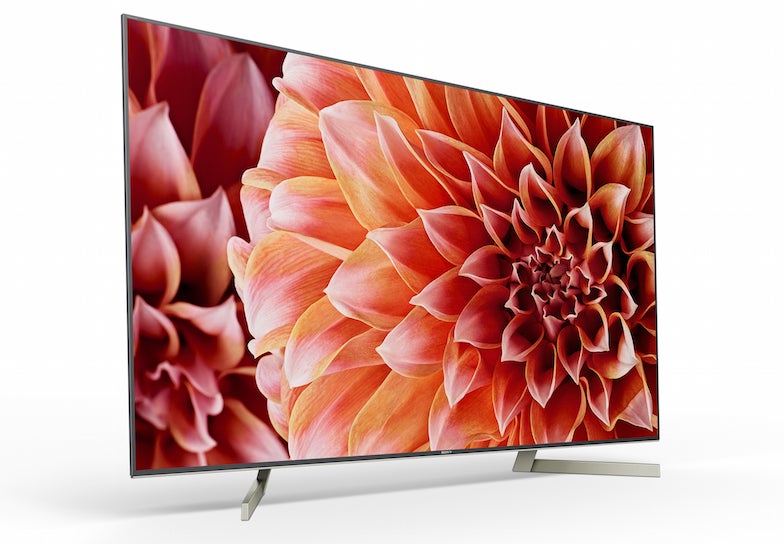
The positioning of these feet also means you’ll need a fairly long piece of furniture to rest the TV on. Unless you wall-hang it, of course.
While the Sony 65XF9005’s feet might look clumsy, they do at least harbour a thoughtful secret: they feature channels into which you can tuck all your cabling.
Accompanying the 65XF9005 is a rather uninspiring remote control. It’s just a typically plasticky, button-heavy affair of the sort you might expect to see with a budget TV rather than a mid-ranger. The way the most important buttons are clustered in a rather random circle around the select button is unhelpful, too.
Sony KD-65XF9005 – Setup
The Sony 65XF9005 is remarkably easy to build for a TV that hides all your cabling away. Each foot just attaches to the screen by a couple of screws, and that’s it.
The initial installation process is a bit more long-winded than some, with multiple terms and conditions to read. But I guess you’re guided through everything straightforwardly enough.
The set did ‘hang’ at the ‘checking for updates’ stage, though, requiring me to skip back and try again. This sort of thing is all too common with the Android TV operating system at the 65XF9005’s heart.
Sony tends to ship its TVs with more helpful presets than most TV brands. It’s therefore no great surprise to find the 65XF9005 delivering excellent pictures right out of the box. That said, there are a couple of setup features worth at least having a play with.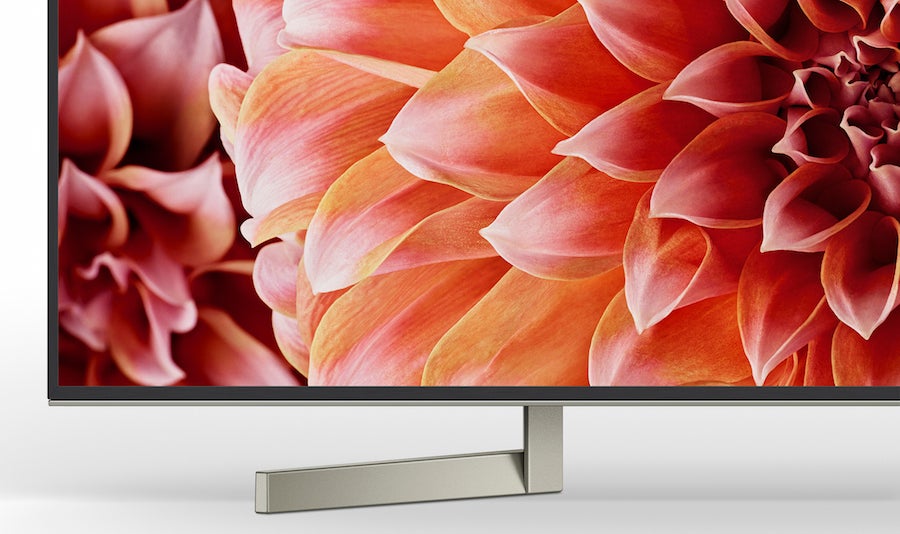
For instance, if you’re watching HDR content that contains lots of extreme contrast, try turning the Adaptive Backlight to Medium rather than High. This marginally reduces black-level depth, but also reduces backlight ‘blooming’ around bright objects.
You might also want to turn off the Film mode motion feature, and experiment with all of Sony’s separate Motionflow settings.
Personally I thought the default Standard Motionflow setting worked very well. But if you don’t mind losing 100 nits or so of brightness, you can also get enjoyably clean judder-reducing results by choosing the Custom setting and setting ‘Cleanness’ to 1 and ‘Smoothness’ to 2.
The only Motionflow setting to avoid is Clear, as this makes the picture too dark – at least for convincing HDR.
One other setting point to consider is that all picture presets except for True Cinema apply automatic HDR up-conversion to standard-dynamic-range sources.
Free £15 Tesco gift card if you buy this TV during the World Cup
Sony KD-65XF9005 – Features
The 65XF9005 uses direct backlighting, where the LEDs sit directly behind the screen. Separate zones of these lights can output different light levels simultaneously, for enhanced contrast. This immediately gives the set a significant advantage over almost all mid-range rivals, which tend to use less precise edge LED lighting.
The XE9005 range took the same direct lighting approach, but Sony claims that the XF9005 models have more individually controllable dimming zones. This should lead to reduced backlight clouding around bright objects.
The 65XF9005 is also brighter than its 2017 predecessor. I measured peak brightness from a 10% white HDR ‘window’ at around 1000 nits – 200 nits more than the XE9005 series. This is a big enough difference to potentially transform HDR playback.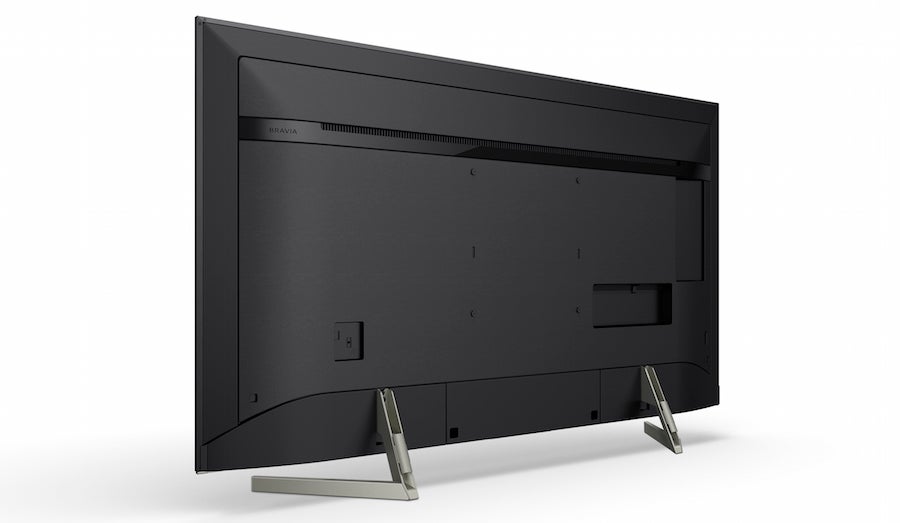
The 65XF9005 deploys Sony’s premium X1 Extreme processor rather than the standard X1 system used in the XE9005 range. The X1 Extreme chip is allegedly 40% more powerful than the older X1, and introduces four key enhancements.
First, it supports Dolby Vision HDR. Or rather, it will support HDR when Sony finally rolls out the necessary firmware update. The US release of this DV firmware caused a few issues that Sony wants to iron out before releasing it here. Until that process is complete, the 65XF9005’s HDR playback covers the HDR10 and broadcast-friendly HLG formats.
The X1 Extreme processor also carries a unique dual-database system for enhanced 4K upscaling of non-4K sources. Plus there’s a Super Bit Mapping system for tackling the colour striping issue that can affect many rival HDR TVs.
Finally, the X1 Extreme processor is responsible for Sony’s impressive SDR-to-HDR up-conversion.
Sony has introduced one all-new picture feature for the XF9005 series: X-Motion Clarity. This is designed to let you use acclaimed black frame insertion technology to improve motion reproduction without the usual accompanying reduction in brightness. It works by using the TVs’ direct LED backlight and local light controls to boost bright picture areas, compensating for the brightness lost by inserting black frames.
As I mentioned briefly earlier, the Sony 65XF9005 depends on Google’s Android TV system for most of its smart features. This, for me, is not a good thing. The Android interface is cluttered and pretty much impossible to customise. It makes little effort to prioritise content most people really want to watch on a TV, either. Nor is it as sophisticated as most modern smart systems at making recommendations based on your viewing habits.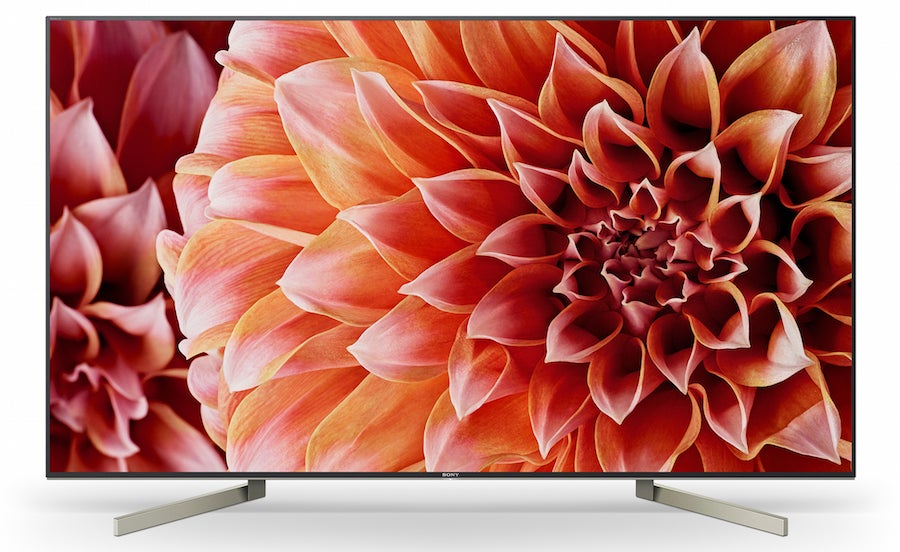
It’s runs slightly sluggishly on the 65XF9005 too, and this sluggishness extends to the TV’s setup menus.
Using Android TV does at least give you built-in Chromecast support, I guess. Also, Sony intends to update the current Android 7 system to the supposedly much-improved Android 8 when it’s available. Fingers crossed that makes things better.
The 65XF9005’s connections are as you’d expect for its money. Four HDMIs and three USBs lead the way, with Bluetooth and Wi-Fi on hand for network connectivity. The HDMIs are v2.0 models; we likely won’t see TVs with the latest v2.1 specification until 2019.
Sony KD-65XF9005 – Performance
In most ways the 65XF9005 delivers a substantial step up in picture quality over its already strong predecessor.
For starters, the set’s extra 200 nits of brightness helps it deliver HDR with far more dynamism and impact. Bright highlights of HDR images – reflections on metal, direct sunlight, gleaming eyes, car headlights and so on – have much more of that stand-out punch we’ve come to expect from the HDR format.
The 65XF9005’s extra native brightness means there’s more detail in the brightest HDR areas too. As Peter arrives in a dazzlingly bright Neverland in Pan, for instance, you can clearly distinguish the glowing ball of a sun next to a floating island, rather than just the general washed-out glow that less impressive HDR TVs show.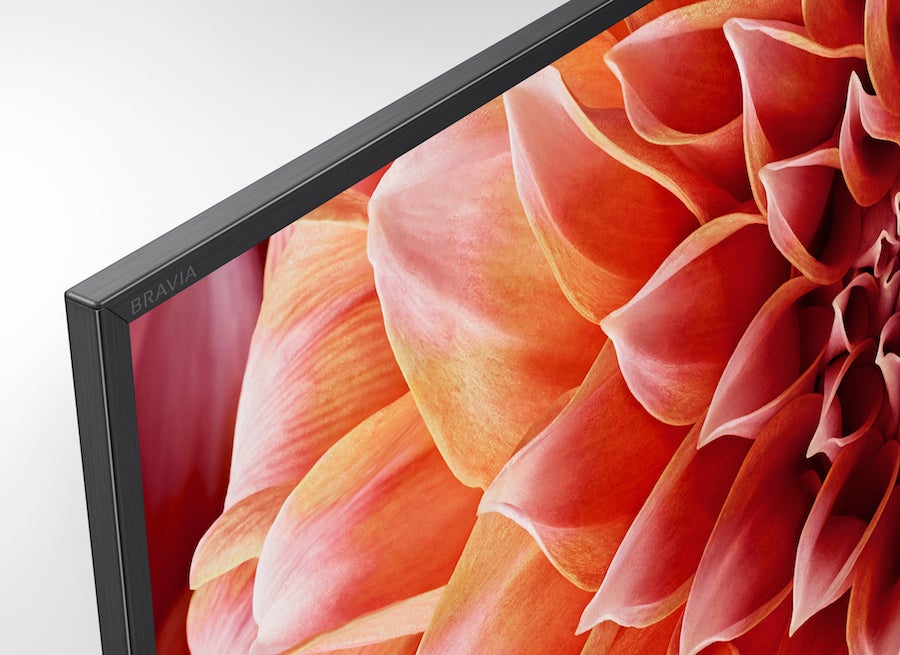
Using the X1 Extreme chipset might be contributing to the reduced clipping of detail in peak bright areas too, by providing improved HDR tone mapping (the process of adapting source images mastered to a higher level of brightness than a screen can natively manage to something it can actually show).
It’s not just brightness peaks that look more convincing on the 65XF9005 than they did on the XE9005 models, though. The screen can also cope better with higher ‘baseline’ HDR brightness levels, such as those seen during daylight sequences on the Planet Earth II 4K Blu-ray. This makes bright HDR scenes, especially exteriors, look much more natural and lifelike. Exactly as they should with HDR.
The 65XF9005’s extra brightness and enhanced processing also transforms its colour performance. Colours from 4K Blu-rays look substantially more vibrant, but also richer in tonal subtleties. This helps pictures look more three-dimensional, solid and authentic, too.
The brightest and darkest colours in the image all look more authentic and balanced than they did on the XE9005 series. This again is down to a combination of the X1 Extreme’s enhanced video processing and the way the extra brightness unlocks more of HDR’s native colour volume potential.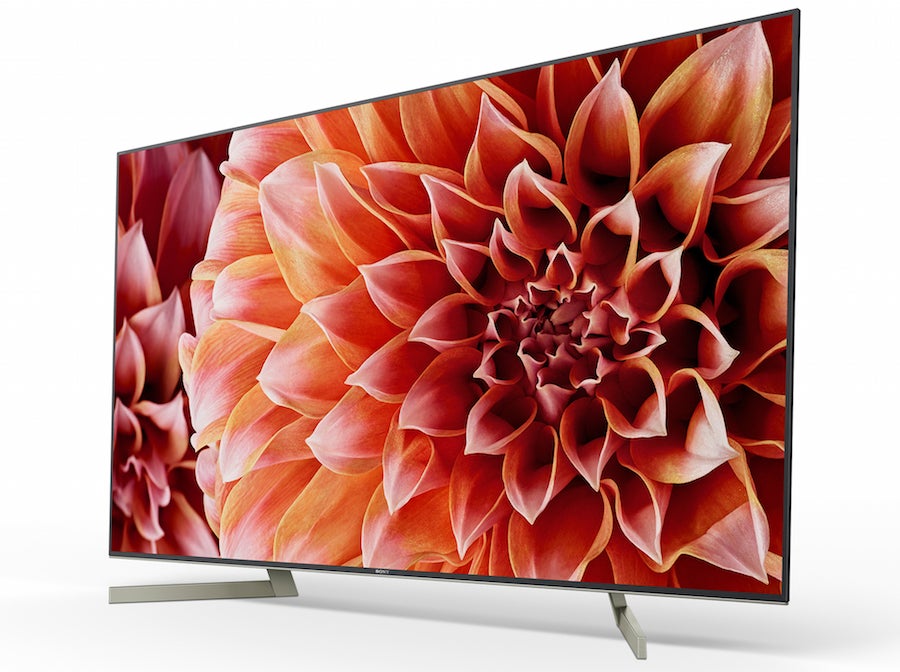
Backing up the Sony 65XF9005’s excellent colour performance is some truly outstanding 4K clarity. You’re jaw-droppingly aware of the difference all those pixels can make to a picture’s sharpness, detail and depth. Especially as there’s no hint of noise or colour bleed to reduce the outstanding texture and clarity.
The stellar ‘4Kness’ of the picture is also enhanced by the 65XF9005’s superlative motion-handling. The new X-Motion Clarity system is a revelation, reducing judder and blur without generating distracting side effects, or leaving the image looking unnaturally smooth. And yes, aside from the ‘Clear’ Motionflow setting, black frame insertion’s benefits are indeed delivered without heavily compromising brightness.
The Sony 65XF9005 continues to outperform the mid-range competition with its playback of non-4K, non-HDR content. The X1 Extreme’s dual database upscaling engine adds millions of pixels to HD sources with almost bewildering accuracy and believability. It also identifies and takes out source noise as if it was as easy as picking bricks out of sand.
Maybe even more remarkable is the X1 Extreme processor’s conversion of SDR sources to HDR. Other TV brands offer SDR-to-HDR conversion too, but none can match the consistently authentic colours and remarkably natural light levels Sony’s conversion system delivers.
If you’d rather watch SDR images in their native form, that’s possible via the True Cinema preset. And the results still look exquisite. Maybe even better when it comes to backlight uniformity in dark scenes. Overall, though, while purists may disagree with me, I think the HDR up-conversion is too good to resist.
The final key aspect of picture quality to cover is the 65XF9005’s contrast performance. This key picture quality element is often my first port of call, but I’ve left it to the end here because it’s a bit complicated.
For the majority of your viewing time the 65XF9005’s contrast performance is outstanding. Its direct lighting and local dimming deliver a wonderfully punchy HDR combination of some of the deepest black levels I’ve seen on an LCD TV, and really intense bright whites and colours.
It’s a joy to experience such extreme contrast without having to worry about the distracting bars of light pollution running right down or across the screen around stand-out objects that you get with edge-lit LCD TVs.
Sony’s light-management is good enough, too, to ensure that even the darkest picture areas still contain detail. They hardly ever look hollowed out or distractingly greyed over.
‘Hardly ever’, though, isn’t quite the same as ‘never’. Even the direct-lit 65XF9005 isn’t totally immune to backlight clouding issues.
Often when a very bright HDR object appears against a very dark backdrop – especially if that bright object is quite small – unwanted light ‘blooms’ can be seen spreading around the bright object for as much as a couple of inches. This suggests that while the 65XF9005 may have more dimming zones than its predecessor, there still aren’t all that many of them compared with the best high-end direct-lit TVs.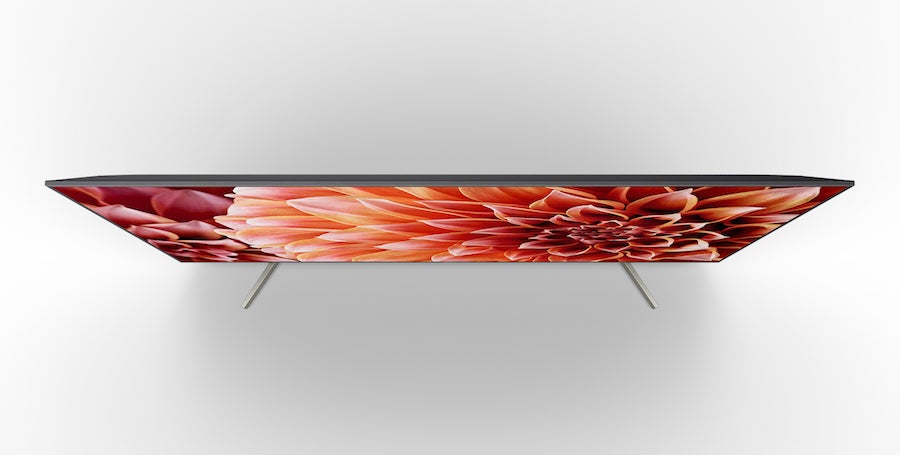
You should take note, too, that the impact of the blooming becomes significantly worse if you have to watch the TV from much of an angle. Either vertical or horizontal.
Before anyone gets too deflated by any of this, however, it’s worth reflecting that the sort of extreme image content that exposes the 65XF9005’s backlight shortcomings is pretty rare.
Also, for the vast majority of the time, even when the clouding appears, it’s subtle enough to pass by more or less unnoticed. Especially if you keep a little light in your room rather than watching in complete darkness.
If you’re thinking the 65XF9005 might be an awesome gaming monitor, in most ways you’d be right. Its formidable colour, contrast and detailing deliver spectacularly impactful gaming graphics. The only issue is that input lag is slightly higher than I’d like, coming it at around 38ms on average when using the Game preset.
Apart from its A1 OLED, Sony hasn’t impressed much with its TV sound quality of late. The 65XF9005, though, is a pleasant step in the right direction. It doesn’t have enough bass to be really outstanding, but it does deliver a wide, well-controlled, clear sound stage. This is backed up by an unexpectedly potent and expansive mid-range, within which voices sound clear and convincing.
There’s lots of detail in the mix too – and this only very occasionally sounds even slightly harsh.
Why buy a Sony KD-65XF9005?
It’s always tricky to cast judgment on the first TVs we see in any given year, as there’s very little context.
In the 65XF9005’s case, though, even though it’s the very first 2018 model to come our way, its unusual combination of a direct lighting array, local dimming and Sony’s X1 Extreme processing make me confident that it will still be a real contender by the time the Christmas sales come around.
In terms of competition, we’re looking at 2017 models right now. One would be Sony’s own 65ZD9. This uses an unprecedented number of dimming zones to deliver the best contrast we’ve seen from an LCD TV to date. It’s fantastically bright and colourful with HDR pictures, too. It launched at £4000, but you can now get it for £2700.
Another option would be the Samsung 65Q7F. This hugely bright, sharp, colour-rich set carries a proprietary screen filter that makes it unprecedentedly fun to watch in bright rooms. If you’re fond of dark-room movie nights, though, you may find its black levels wanting.
If you can sacrifice 10 inches of screen size, one other alternative would be a 55-inch LG OLED TV. The LG OLED55B7V is now widely available for just £1800.
Verdict
Even the 65XF9005’s direct lighting and local dimming can’t deliver perfect HDR pictures – but where it struggles, similarly priced 65-inch rivals struggle more. And when it isn’t struggling, it looks so stunning that you’d swear you were watching a high-end TV, not a mid-range one.
How we test televisions
We test every TV we review thoroughly over an extended period of time. We use industry standard tests to compare features properly. We’ll always tell you what we find. We never, ever, accept money to review a product.
Trusted Score
Score in detail
-
Features 9
-
Value 8
-
Smart TV 7
-
Image Quality 9
-
Design 7
-
Sound Quality 8
Features
| Size (Inch) | 65 |
| Display Type | LED |
| Max. Resolution | 3840 x 2160 |
| Full HD 1080p | Yes (actually 4K) |
| Digital Tuner | Yes |
| Freeview HD | Yes |
| Freesat HD | No |
| 3D Ready | No |
| Refresh Rate (Hertz) | 50 |
Connectivity
| HDMI | 4 |
| Component | 1 |
| Digital Audio Out | Yes (optical) |
| Headphone | Yes |
| Ethernet | Yes |
| WiFi | Yes |
Physical Specifications
| Height (Millimeter) | 829 |
| Width (Millimeter) | 1447 |
| Depth (Millimeter) | 69 |
| Weight (Gram) | 24500 |


